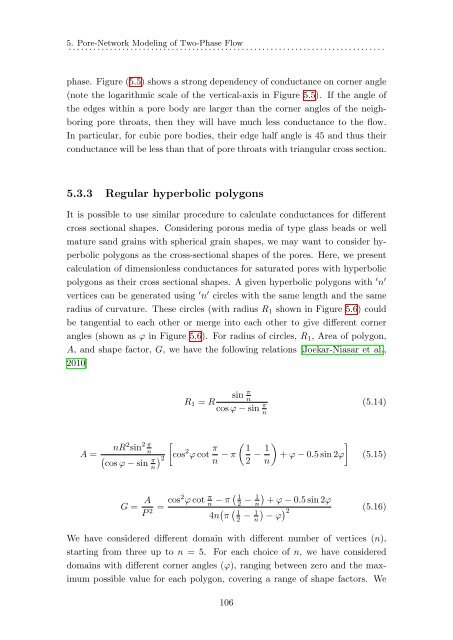download pdf version of PhD book - Universiteit Utrecht
download pdf version of PhD book - Universiteit Utrecht
download pdf version of PhD book - Universiteit Utrecht
You also want an ePaper? Increase the reach of your titles
YUMPU automatically turns print PDFs into web optimized ePapers that Google loves.
5. Pore-Network Modeling <strong>of</strong> Two-Phase Flow<br />
. . . . . . . . . . . . . . . . . . . . . . . . . . . . . . . . . . . . . . . . . . . . . . . . . . . . . . . . . . . . . . . . . . . . . . . . . . . . .<br />
phase. Figure (5.5) shows a strong dependency <strong>of</strong> conductance on corner angle<br />
(note the logarithmic scale <strong>of</strong> the vertical-axis in Figure 5.5). If the angle <strong>of</strong><br />
the edges within a pore body are larger than the corner angles <strong>of</strong> the neighboring<br />
pore throats, then they will have much less conductance to the flow.<br />
In particular, for cubic pore bodies, their edge half angle is 45 and thus their<br />
conductance will be less than that <strong>of</strong> pore throats with triangular cross section.<br />
5.3.3 Regular hyperbolic polygons<br />
It is possible to use similar procedure to calculate conductances for different<br />
cross sectional shapes. Considering porous media <strong>of</strong> type glass beads or well<br />
mature sand grains with spherical grain shapes, we may want to consider hyperbolic<br />
polygons as the cross-sectional shapes <strong>of</strong> the pores. Here, we present<br />
calculation <strong>of</strong> dimensionless conductances for saturated pores with hyperbolic<br />
polygons as their cross sectional shapes. A given hyperbolic polygons with ′ n ′<br />
vertices can be generated using ′ n ′ circles with the same length and the same<br />
radius <strong>of</strong> curvature. These circles (with radius R 1 shown in Figure 5.6) could<br />
be tangential to each other or merge into each other to give different corner<br />
angles (shown as ϕ in Figure 5.6). For radius <strong>of</strong> circles, R 1 , Area <strong>of</strong> polygon,<br />
A, and shape factor, G, we have the following relations [Joekar-Niasar et al.,<br />
2010]<br />
sin π n<br />
R 1 = R<br />
cos ϕ − sin π n<br />
(5.14)<br />
A =<br />
nR 2 sin 2 π [<br />
n<br />
( )<br />
cos ϕ − sin<br />
π 2<br />
cos 2 ϕ cot π ( 1<br />
n − π 2 − 1 )<br />
]<br />
+ ϕ − 0.5 sin 2ϕ<br />
n<br />
n<br />
(5.15)<br />
G = A P 2 = cos2 ϕ cot π n − π ( 1<br />
2 − n) 1 + ϕ − 0.5 sin 2ϕ<br />
4n ( π ( 1<br />
2 − ) ) 1 2<br />
(5.16)<br />
n − ϕ<br />
We have considered different domain with different number <strong>of</strong> vertices (n),<br />
starting from three up to n = 5. For each choice <strong>of</strong> n, we have considered<br />
domains with different corner angles (ϕ), ranging between zero and the maximum<br />
possible value for each polygon, covering a range <strong>of</strong> shape factors. We<br />
106

















